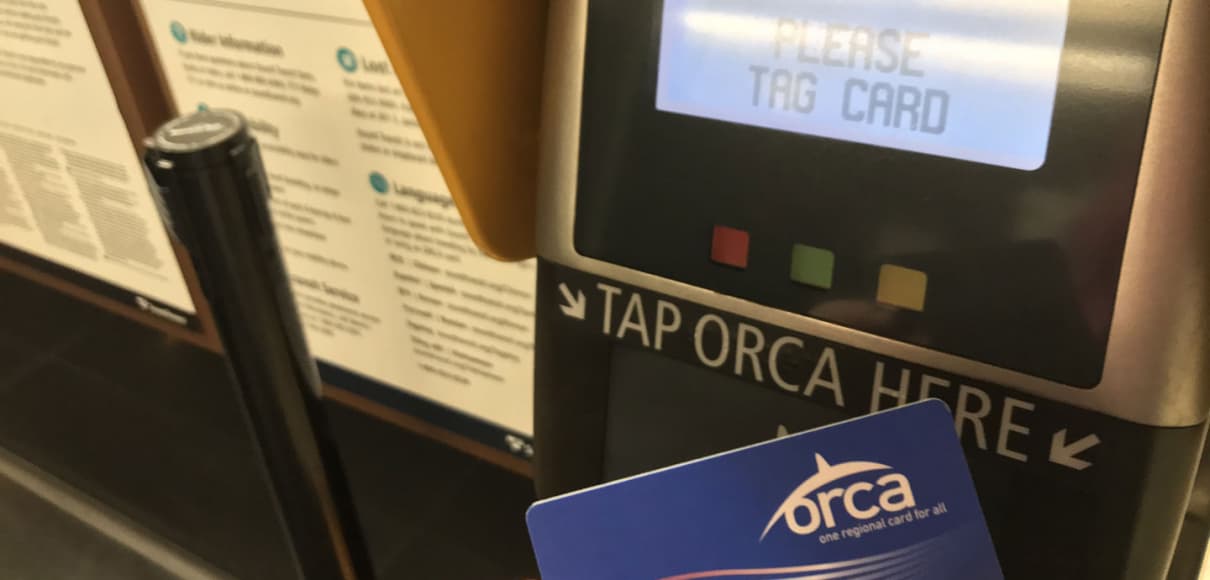Not everyone has a car on campus, but even if you do, you may not want to deal with the expense and hassle of parking around the city. Here’s what you need to know about getting around town using public transportation:
1. Plan your trip online before heading out.
King County has a helpful website for trip planning.
Just input your starting point and your destination; the planner will generate several transit options. You may have to transfer buses, so this makes the process more straightforward. Routes 3, 4, and 13 run from downtown directly to SPU.
You can also download the Puget Sound Trip Planner app on your photo which provides information on all area public transportation options — light rail, bus, train, ferries and water taxis, the monorail, and city streetcars. The free app has maps, route schedules, fares, and walking distances, and even service alerts.
2. Get an ORCA card.
This is your best friend when it comes to hassle-free commuting. Rather than having to dig around for $2.75 in change, an ORCA card allows you to scan and be on your merry way. ORCA stands for “One Regional Card for All,” and is accepted on all transit services provided by King County Metro, Sound Transit, Monorail, Seattle Streetcar, Community Transit, Kitsap Transit, Everett Transit, Pierce Transit, and Washington State Ferries. In some instances, you will scan prior to boarding (e.g. Rapid Ride bus lines, Light Rail, Washington State Ferries); with most buses, you will scan as you board the vehicle.
You can purchase an ORCA online, from vending machines at light rail stations, or from certain retail outlets. Once you have purchased it, you can preload the card with travel funds. SPU offers discounted ORCA cards, which you can apply for through Banner. You can find out more about the ORCA card here.
3. Footwear matters.
Here’s a shocker: Seattle is often rainy and wet. When I first began commuting, I thought I could just power through it in a pair of Converse, and while that’s a noble and brave sentiment, my socks did not appreciate the outcome. If you don’t want to sacrifice fashion for function — I feel your pain! — there are some surprisingly chic, water-resistant footwear options for women.
If you work an office job like I do, you can always pack office shoes to change into — or you can rock some super cute rainboots for casual Friday.
4. Use One Bus Away or a similar app.
There are apps that can update you on how far away a bus is, which can be super helpful if your travel is time sensitive. One Bus Away pushes out real-time updates, which means that you can give others an accurate estimate of your arrival time.

5. Make sure you’re headed in the right direction.
If you are not the most navigationally competent individual (like me), your phone’s map is your best friend. Try to figure out the general direction you’re heading. For instance, if you’re starting at SPU and going downtown, you’re going south, so make sure you’re at the southbound bus stop and not the northbound one across the street. If you get confused, you can always ask the bus driver as you’re boarding.
6. Follow transit etiquette.
Public transit is much more pleasant when everyone is mindful of their surroundings. For example, placing your backpack on your lap or on the ground makes more space for others to sit or stand. Try to avoid putting your feet on the seats, resting your head on the seat in front of you, etc. If a senior or disabled individual boards a crowded bus, it’s always a kind gesture to offer them your seat.
7. Make sure to request your stop.
While this is likely a no-brainer if you grew up in a city, if you grew up in a small town without a bus system, it might not occur to you. On buses in Seattle, you can request your stop by pulling the yellow cord that runs along the side of the bus. For other services like the Light Rail, you don’t need to request your stop, as the operator stops at each destination along the way.

8. Bring a buddy the first few times.
One of the worst feelings in the world is getting lost. Having a friend with you can turn getting lost into an adventure.
9. Long ride? Grab some headphones.
Create a playlist or download an episode of your favorite podcast to make the ride fly by. Just make sure you don’t lose track of your surroundings or forget to request your stop!
10. Go on adventures, be brave, and enjoy the view.
Don’t let anxiety surrounding the commuting process deter you from exploring all that Seattle and the surrounding areas have to offer. The transit systems mean you don’t have to look for parking, and one of the best parts of traveling by public transit is that you can sit back, relax, and enjoy the sights of Seattle. The light rail offers some stunning views of the city, including some pretty remarkable street art. Or grab some extra study time. You’re likely to make mistakes. You’re likely to head the wrong direction a few times. That’s completely okay! It’s all part of the process, and before you know it, you’ll be so used to transit you’ll hardly have to think about the logistics of your trip.




